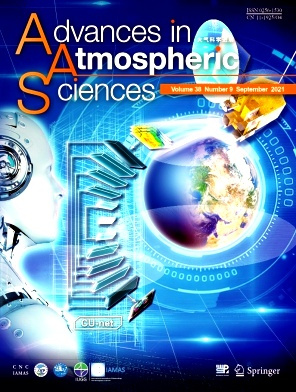
Advances in Atmospheric Sciences
Advances in Atmospheric Sciences
- 主管单位:中国科学院出版图书情报委员会
- 主办单位:中国科学院大气物理研究所
- 期刊收录: 万方收录知网收录维普收录CA 化学文摘(美)统计源核心期刊JST 日本科学技术振兴机构数据库(日)SA 科学文摘(英)SCI 科学引文索引(美)CSCD 中国科学引文数据库来源期刊
- 期刊荣誉: 中国优秀期刊奖
- 主要栏目:
Articles;Notes and Correspondence;Letters
Advances in Atmospheric Sciences杂志简介
《Advances in Atmospheric Sciences》杂志是由中华人民共和国新闻出版总署、正式批准公开发行的优秀期刊。
《Advances in Atmospheric Sciences》自创刊以来,以新观点、新方法、新材料为主题,坚持"期期精彩、篇篇可读"的理念。
《Advances in Atmospheric Sciences》内容详实、观点新颖、文章可读性强、信息量大,众多的栏目设置,Advances in Atmospheric Sciences公认誉为具有业内影响力的杂志之一。Advances in Atmospheric Sciences并获中国优秀期刊奖,现中国期刊网数据库全文收录期刊。
《Advances in Atmospheric Sciences》现为国家自然科学基金委员会重点资助期刊,是大气科学领域的学术性刊物,坚持“百花齐放,百家争鸣”的方针,努力反映大气科学领域的最新研究成果,及时刊登有创造性的学术论文及评述性文章,报道大气科学领域内的新动向、新问题。国内外大气科学领域著名科学家均向我刊投稿,编委由国内外大气科学领域知名科学家共40多人组成。
Advances in Atmospheric Sciences杂志投稿
Advances in Atmospheric Sciences杂志投稿须知:
1、Manuscript componentsEach manuscript should include the following components, presented in the order shown.1) Title, name, affiliation of each author and corresponding author's email provided on the title page.2) Abstract. A brief, concise abstract is required at the beginning of each manuscript. The abstract contains a brief account of the background and rationale of the work, followed by a statement of the main conclusions. The abstract is typically 250 words or less in length and is unreferenced. The abstract should be 250 words or less in length. The abstract should not contain any mathematical expressions if possible, should include no footnotes or citations, and should not contain first-person sentence structure.3) Key words. 4-6 key words should be provided.4) Text. The text (12-point) should be typesetted in one column, divided into sections, each with a separate heading and numbered consecutively using following format1. Primary heading1.1 Secondary heading1.1.1 Tertiary heading1.1.1.1 Quaternary heading5) Acknowledgements. Keep this section as brief as possible by acknowledging only direct assistance in your research and writing. Financial support for the work done should be acknowledged here rather than as footnotes to the title.6) References. References should be arranged alphabetically without numbering. Citations to standard references in text should consist of the name of the author and the year of publication—for example, Wang (1990) or (Wang, 1990). If there are three or more authors, state the first author’s surname, followed by "et al." and the year of publication—for example, Wang et al. (1990) or (Wang et al., 1990). When there are two or more papers by the same author or authors in the same year, distinguishing letters (a, b, c, etc.) should be added to the year in both the citation in text and the reference listing, for example, Wang (1990a). For multiple citations by one author, separate years by commas, for example, Wang (1989, 1990) or (Wang, 1989, 1990). Separate multiple citations by different authors within the same parentheses by semicolons, for example, (Wang, 1990; Li, 1991) or (Wang, 1989, 1990; Li, 1991).7) Figure captions. Each figure must be supplied with a self-explanatory caption and all captions should be listed together. Authors should also include captions below the figures for the reviewer copies.8) Illustrations and tables. Each figure and table should be numbered consecutively and cited specifically in the text by number. All tables should have a title or legend.。
2、FormulasBrief equations or terms set inline in text must be set as a single line expression, if possible. Also please enter them directly from the keyboard if possible. For more complex variables that have both subscripts and superscripts, or have a more complicated operator such as a radical sign, use of the MathType equation editor is recommended.。
3、ReferencesReferences should be given alphabetically without numbering at the end of the paper. References must be complete and properly formatted and only literature cited in the text can be listed.1、 For typical journal citations it follows the form:Author(s), publication year: Article title. Journal name, volume, page range.For example,Boville, B. A., and J. W. Hurrell, 1998: A comparison of the atmospheric circulations simulated by the CCM3 and CSM1. J. Climate, 11, 1327–1341.2、 For a book it follows the form:Author(s), publication year: Book Title. Publisher, total pages.For example,Pedlosky, J., 1987: Geophysical Fluid Dynamics. 2nd ed., Springer-Verlag, 710pp.3、 For a chapter in a book it follows the form:Author(s), publication year: chapter title. Book Title, Editor(s), Publisher, page range.For example,Zhang, R. H., and J. P. Chao, 1993: Mechanisms of interannual variations in a simple air-sea coupled model in the tropics. Climate Variability, D. H. Ye, et al., Eds., China Meteorological Press, Beijing, 236–244.。
4、 For a website, it follows the form: Chou, M.-D., and M. J. Suarez, 1994: An efficient thermal infrared radiation parameterization for use in general circulation model. NASA Tech. Memo. 104606, Vol. 3, 85 pp. [Available online at NASA/Goddard Space Flight Center, Code 913, Greenbelt, MD 20771.]4、FiguresVector-based figures (eps., ai., or psd.) should be provided upon acceptance of a paper.。
5、AnimationAAS accepts submission with animation. Authors can submit it as supplementary materials via ScholarOne if the video is less than 10 M. The format flv. (or mpeg, avi, etc.) is desired. If the video is more than 10 M, authors are suggested providing a URL of the video for the convenience of the reviewers. The original video can be sent to the Editorial Office upon acceptance of the paper.。
6、Copyright informationAs a member of Committee on Publication Ethics (COPE), Advances in Atmospheric Sciences conforms to Code of Conducts and Guidelines of the Committee on Publication Ethics and is committed to publishing original work by the named author or authors.As soon as an article is submitted, authors will be requested to assign copyright of the article (or to grant exclusive publication and dissemination rights) to the publisher (respective the owner if other than Springer). This will ensure the widest possible protection and dissemination of information under copyright laws.
Advances in Atmospheric Sciences投稿地址
- 官网地址:159.226.119.58/aas/EN/volumn/home.shtml
- 投稿邮箱:aas@mail.iap.ac.cn
- 联系电话:010-82995054
- 杂志社地址:北京德胜门外中科院大气所
Advances in Atmospheric Sciences统计分析
影响因子:指该期刊近两年文献的平均被引用率,即该期刊前两年论文在评价当年每篇论文被引用的平均次数
被引半衰期:衡量期刊老化速度快慢的一种指标,指某一期刊论文在某年被引用的全部次数中,较新的一半被引论文刊载的时间跨度
他引率:期刊被他刊引用的次数占该刊总被引次数的比例用以测度某期刊学术交流的广度、专业面的宽窄以及学科的交叉程度
引用半衰期:指某种期刊在某年中所引用的全部参考文献中较新的一半是在最近多少年时段内刊载的
平均引文数:在给定的时间内,期刊篇均参考文献量,用以测度期刊的平均引文水平,考察期刊吸收信息的能力以及科学交流程度的高低
相关推荐更多
热门评论
总体还是蛮快的。感觉杂志非常正规专业,审稿专家给出的修改建议都很有价值,编辑对格式的要求很高,很高兴投了本杂志,希望《Advances in Atmospheric Sciences》越办越好。
Advances in Atmospheric Sciences的编辑,非常负责任,而且修改意见写得也非常详细明确,本人觉得该期刊在国内来说,专业、负责,发展会越来越好的。感觉不是很难发表的,只要是符合该刊物的要求有一定的新意即可。
已投多次修改后录用,审稿周期较快,1个月录用,专家所提意见很到位也很详细。本人普通院校小硕一枚,第一次投该杂志(因看大家对该刊评论较好),另有多名同学也投过该杂志,都是修改后录用,该刊十分重视论文格式,希望对打击有帮助!
杂志的处理速度还是很快的,审稿流程也非常规范,不会让作者盲目等候。审稿人比较严谨,意见非常犀利,提出来的问题很好,让我有更深入的思考。提了10多个问题,对提升文章档次很有帮助!
编辑部老师的态度每次都非常好。邮件回复也很快。1个月零7天后就可以催稿,而且该期刊是欢迎催告。建议关注Advances in Atmospheric Sciences的新浪微博,通过上面的谈论,可以对整个投稿过程有个更清晰的了解。
Advances in Atmospheric Sciences审稿速度也快,最近投了一篇3个月内录用了,外审7天修回,然后自己拖了一个星期给修回编辑后过两天就录用了。
我是.12月12日投稿,修改意见是12月23日回来的,提的意见很中肯, 27日修改后直接录用~版面费有点贵 但是速度还是可以的 就是不知道发表是什么时候了
两个外审按时返回意见,外审两个月了都还没回信,给编辑部打电话,第一次说催下,确实催了有效果,给了我的修改意见,改了就录用了。Advances in Atmospheric Sciences要求文章要有创新,有自己的东西,行文要流畅,尽量避免错字、歧义语句。
我没发现编辑部态度好,我有篇文章初审超过2个月,打电话咨询下为什么初审这么久,那编辑很不耐烦,说让等,态度相当不好。。。感觉说话的语气像欠她钱一样,晕惨了。
首先编辑人很好。投稿后需要自己电话咨询稿件状态,如果文章有基金支持有很大被录用的可能,见刊也很快,一般来说都是3个月。版面费有点小贵。希望以后越办越好。
常见问题
| Q:论文发表的时候可以一稿多投吗? |
| A:一稿多投的行为是典型的学术不端的行为,是国内外学术界都明令禁止的行为,原因主要在于涉及到文章版权归属的问题,如果作者的文章已经被某个杂志社录用,或者同时被两家杂志社录用,就会涉及到版权纠纷,作为杂志社都会保护本社的合法权益,到这时作者就会比较麻烦,吃官司都是小事儿了,被打入黑名单降级降职影响可就太大了。 |
| Q:职称论文发表对时间有限制吗? |
| A:职称论文发表并没有明确规定截止时间,需要作者结合自己所在地区的具体规定自己安排发表时间,一般职称评审,各地区都会明确规定申报材料的最后期限和截止日期,我们结合这个日期来考虑何时发表文章就可以,大部分地区职称评审都集中在每年的8-10月之间,有的地区要求7月中旬开始交材料,最晚8月底之前,有的则是要求8月中旬交,还有部分地区要求截止时间为申报时间上年的12月31日,所以,各个地区的具体要求并不同,申报者需要在提交材料前确保自己的文章已经见刊并且被相应的数据库检索即可。 |
| Q:网上发表论文如何防骗?可靠网站与可疑网站如何区分? |
| A:由于发表论文的需求远远多于杂志版面的供应,再加上众所周知的审稿难!审稿慢!选择论文发表网站发表表论文确实能解决以上问题。卖方市场的出现加之发表论文的刚性需求,就导致出现先付款后发表的现状。论文发表网站正规与否是通过网站从始至终所提供服务体现出来的,任何交易只要存在时间差都会有风险,但这个风险是可以通过您的智慧来避免的。因为不是所有论文网站都是骗子,你要做的就是过滤掉没保障的网站,选择可靠的论文发表网站! |
| Q:一般期刊需要提前多久准备? |
| A:省级、国家级期刊建议至少提前6个月准备。一般来讲,杂志社为了确保每期杂志正常出刊,都会提前将当期之后1-3个月的稿件提前安排好,而一些创刊较早,认可度更高的热门期刊,来稿量较大,发表周期可能就会更久。提前准备,意味着杂志的可选择性更多。 |
| Q:核心期刊需要提前多久准备? |
| A:核心期刊建议至少提前12个月准备,核心期刊正常的审稿周期为1-3个月,且审核严格,退稿、返修几率更大,这意味着在流程上耗费的时间更久,且核心期刊版面有限,投稿竞争更加激烈,即使被录用,排刊也比普通期刊晚很多,因此需要更早准备。 |